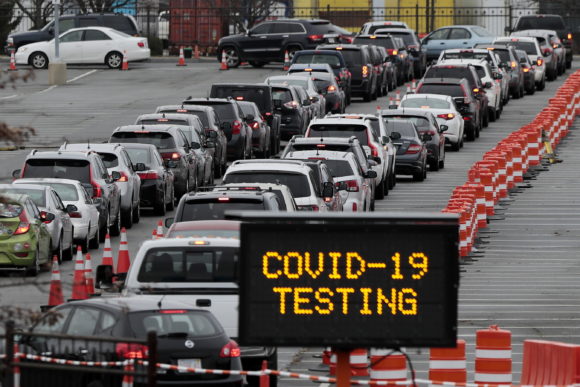While at least 17 states have passed laws or issued orders that expanded access to workers’ compensation benefits for employees who contract COVID-19, many of those directives are creating new exposure for only a sliver of the workforce, new research by the Workers’ Compensation Research Institute shows.
WRCI studied policies adopted by Alaska, Arkansas, Indiana, Kentucky, Minnesota and Missouri in response to the pandemic. Researchers found that the broadest expansion of the six states — an executive order issued by Kentucky Gov. Andy Beshear — created additional claim exposure for only 4% of the state’s workers, when adjusted to account for the risk of exposure. The orders expanded exposure by more than 3% but less than 4% of workers in each of the other states except Minnesota, at 2.8%; and Missouri, at 0.8%.
Chief Executive Officer and President John Ruser said in an email that WCRI intends to study all of the states that adopted presumptions that COVID-19 is a workplace illness or took other actions that make it easier for workers to file COVID-19 claims.
Most of the six states studied so far adopted relatively modest measures to expand access to workers’ comp. WCRI had not yet analyzed broad presumption laws adopted by California, Illinois and Vermont, but Ruser said the Institute will release more reports in the coming weeks.
“States vary greatly in terms of the potential scope of coverage and California and Illinois are two states with broader coverage,” he said. “We will cover them in our reports.”
The insurance industry rang alarm bells this spring when governors began adopting executive orders and a flurry of legislation was introduced to create rebuttable presumptions for COVID-19. Many of those orders address health care workers or first responders. Kentucky went a bit further, adding grocery store workers, child-care workers and other miscellaneous job categories to the presumption.
Some states have expanded access to comp by means other than new presumptions. The Indiana Workers’ Compensation Board simply urged employers to consider whether any vulnerable segments of their workforces should be presumptively covered. Arkansas made workers in jobs that make COVID-19 exposure likely eligible for workers’ compensation benefits, which otherwise would otherwise be denied because of state law that bars coverage for ordinary diseases of life.
WCRI methodically broke down the additional claim exposure created by each state order by determining the number of workers in each job category potentially covered and then reducing that total to account for the level of exposure, based on a “risk pyramid” created by the Occupational Safety and Health Administration. For example, 880 Missouri police officers are covered by a presumption for first responders, but their risk of exposure to the coronavirus is only moderate according to OSHA, so WCRI converted that number to 440.
Ruser said the goal of the study is to reflect relative risk. He said a state with a large number of workers covered by a presumption, but most of them in a low-risk profile, has less exposure to COVID-19 claims than a state with an equal number or workers covered but in a high-risk profile.
COVID-19 had made up a growing share of workers’ compensation claims, while claims for other conditions has dropped.
James Lynch, chief actuary and senior vice president of research and education for the Insurance Information Institute, said early reports from Texas, California and Florida show that a large number of COVID-19 claims have been offset by from a decline in other injury claims because more people are working from home, leaving insurers’ loss ratios “virtually unchanged versus last year.”
“Thus far, it appears that the average COVID claim is smaller than the average non-COVID claim, but of course much of the data precedes the most recent outbreak we are seeing across the U.S.,” Lynch said in an email. “At Triple-I, we are also watching the long-term COVID claims, which may have a downstream impact on the workers’ comp line of business”
In Texas, more than 25,000 workers’ compensation claims, including 100 fatalities, were reported as of Sept. 27 in a data call by the state Division of Workers’ Compensation’s Research and Evaluation Group. Insurance carriers accepted 48% of them. Most of the claims and fatalities involved first responders and correctional officers/prison workers.
The DWC said the total number of workers’ comp claims for all injury and illness types was 22,000 higher than last year’s total at the same date.
The California Workers’ Compensation Institute reports that 56,854 claims were reported in California as of Nov. 30. That includes 312 death claims. COVID-19 made up 12.8% of all workers’ comp claims in the state. The total number of claims reported as of Nov. 30 had dropped by 12.9%, compared to 2019, the CWCI data shows. California had 588,506 workers comp claims by this time last year, compared to 484,252 in the first 11 months of 2020.
The Florida Division of Workers’ Compensation reported that 23,452 COVID-19 claims had been filed as of Oct. 31 and $17.4 million in benefits have been paid. COVID-19 made up 31.1% of all indemnity claims in Florida.
In Pennsylvania, 9,679 COVID-19 workers’ compensation claims had been filed as of Tuesday, according to statistics collected by the Pennsylvania Bureau of Workers’ Compensation. The number of claims reported each day has been rapidly increasing: Up until November, the daily total rarely exceeded 100. But 205 COVID-19 claims were reported on Nov. 22 and 373 on Nov. 29.
About the photo: Hundreds of motorists line up at the Whale’s Tooth parking lot in New Bedford, Mass., to be tested for COVID-19. (Peter Pereira/The Standard-Times via AP)
Was this article valuable?
Here are more articles you may enjoy.


 Nearly 24 Firms Seek Deal With CFTC to Settle Enforcement Cases
Nearly 24 Firms Seek Deal With CFTC to Settle Enforcement Cases  In Fight Over Insurance, Neighbors Crowdsource LA Fire Contamination Data
In Fight Over Insurance, Neighbors Crowdsource LA Fire Contamination Data  Trump’s Tariffs Send Deliberate Shock to Heart of Global Economy
Trump’s Tariffs Send Deliberate Shock to Heart of Global Economy  Jack Dorsey’s Block to Pay New York $40 Million in Cash App Settlement
Jack Dorsey’s Block to Pay New York $40 Million in Cash App Settlement 